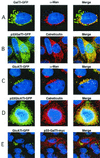Enzyme interactions in heparan sulfate biosynthesis: uronosyl 5-epimerase and 2-O-sulfotransferase interact in vivo
- PMID: 11687650
- PMCID: PMC60811
- DOI: 10.1073/pnas.241175798
Enzyme interactions in heparan sulfate biosynthesis: uronosyl 5-epimerase and 2-O-sulfotransferase interact in vivo
Abstract
The formation of heparan sulfate occurs within the lumen of the endoplasmic reticulum-Golgi complex-trans-Golgi network by the concerted action of several glycosyltransferases, an epimerase, and multiple sulfotransferases. In this report, we have examined the location and interaction of tagged forms of five of the biosynthetic enzymes: galactosyltransferase I and glucuronosyltransferase I, required for the formation of the linkage region, and GlcNAc N-deacetylase/N-sulfotransferase 1, uronosyl 5-epimerase, and uronosyl 2-O-sulfotransferase, the first three enzymes involved in the modification of the chains. All of the enzymes colocalized with the medial-Golgi marker alpha-mannosidase II. To study whether any of these enzymes interacted with each other, they were relocated to the endoplasmic reticulum (ER) by replacing their cytoplasmic N-terminal tails with an ER retention signal derived from the cytoplasmic domain of human invariant chain (p33). Relocating either galactosyltransferase I or glucuronosyltransferase I had no effect on the other's location or activity. However, relocating the epimerase to the ER caused a parallel redistribution of the 2-O-sulfotransferase. Transfected epimerase was also located in the ER in a cell mutant lacking the 2-O-sulfotransferase, but moved to the Golgi when the cells were transfected with 2-O-sulfotransferase cDNA. Epimerase activity was depressed in the mutant, but increased upon restoration of 2-O-sulfotransferase, suggesting that their physical association was required for both epimerase stability and translocation to the Golgi. These findings provide in vivo evidence for the formation of complexes among enzymes involved in heparan sulfate biosynthesis. The functional significance of these complexes may relate to the rapidity of heparan sulfate formation.
Figures






Similar articles
-
EJ-ras oncogene transfection of endothelial cells upregulates the expression of syndecan-4 and downregulates heparan sulfate sulfotransferases and epimerase.Biochimie. 2006 Oct;88(10):1493-504. doi: 10.1016/j.biochi.2006.04.009. Epub 2006 May 11. Biochimie. 2006. PMID: 16793191
-
Stem domains of heparan sulfate 6-O-sulfotransferase are required for Golgi localization, oligomer formation and enzyme activity.J Cell Sci. 2004 Jul 1;117(Pt 15):3331-41. doi: 10.1242/jcs.01191. J Cell Sci. 2004. PMID: 15226404
-
C5-epimerase and 2-O-sulfotransferase associate in vitro to generate contiguous epimerized and 2-O-sulfated heparan sulfate domains.ACS Chem Biol. 2015 Apr 17;10(4):1064-71. doi: 10.1021/cb501037a. Epub 2015 Jan 28. ACS Chem Biol. 2015. PMID: 25594747
-
"Coding" and "Decoding": hypothesis for the regulatory mechanism involved in heparan sulfate biosynthesis.Carbohydr Res. 2016 Jun 16;428:1-7. doi: 10.1016/j.carres.2016.04.002. Epub 2016 Apr 8. Carbohydr Res. 2016. PMID: 27088396 Review.
-
Sulfation pattern in glycosaminoglycan: does it have a code?Glycoconj J. 2004;21(1-2):47-52. doi: 10.1023/B:GLYC.0000043747.87325.5e. Glycoconj J. 2004. PMID: 15467398 Review.
Cited by
-
Structure of the human heparan sulfate polymerase complex EXT1-EXT2.Nat Commun. 2022 Nov 19;13(1):7110. doi: 10.1038/s41467-022-34882-6. Nat Commun. 2022. PMID: 36402845 Free PMC article.
-
Genetic analysis of the heparan modification network in Caenorhabditis elegans.J Biol Chem. 2011 May 13;286(19):16824-31. doi: 10.1074/jbc.M111.227926. Epub 2011 Mar 24. J Biol Chem. 2011. PMID: 21454666 Free PMC article.
-
Tetrasulfated disaccharide unit in heparan sulfate: enzymatic formation and tissue distribution.J Biol Chem. 2008 Nov 7;283(45):31237-45. doi: 10.1074/jbc.M801586200. Epub 2008 Aug 28. J Biol Chem. 2008. PMID: 18757372 Free PMC article.
-
The role of heparan sulphate in development: the ectodermal story.Int J Exp Pathol. 2016 Jun;97(3):213-29. doi: 10.1111/iep.12180. Epub 2016 Jul 6. Int J Exp Pathol. 2016. PMID: 27385054 Free PMC article. Review.
-
Downstream Products are Potent Inhibitors of the Heparan Sulfate 2-O-Sulfotransferase.Sci Rep. 2018 Aug 7;8(1):11832. doi: 10.1038/s41598-018-29602-4. Sci Rep. 2018. PMID: 30087361 Free PMC article.
References
-
- Lindahl U, Kusche-Gullberg M, Kjellén L. J Biol Chem. 1998;273:24979–24982. - PubMed
-
- Shworak N W, Liu J A, Petros L M, Zhang L J, Kobayashi M, Copeland N G, Jenkins N A, Rosenberg R D. J Biol Chem. 1999;274:5170–5184. - PubMed
-
- Aikawa J, Grobe K, Tsujimoto M, Esko J D. J Biol Chem. 2001;276:5876–5882. - PubMed
-
- Habuchi H, Tanaka M, Habuchi O, Yoshida K, Suzuki H, Ban K, Kimata K. J Biol Chem. 2000;275:2859–2868. - PubMed
Publication types
MeSH terms
Substances
Grants and funding
LinkOut - more resources
Full Text Sources
Other Literature Sources
Molecular Biology Databases

